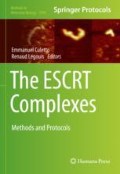Abstract
Live imaging of microfluidically isolated axons permits study of the dynamic behavior of fluorescently tagged proteins and vesicles in these neuronal processes. We use this technique to study the motility and transport of ESCRT proteins in axons of primary hippocampal neurons. This chapter details the preparation of microfluidic chambers, as well as the seeding, fluidic isolation, and lentiviral transduction of hippocampal neurons in these chambers, optimized for the study of ESCRT protein dynamics.
Access this chapter
Tax calculation will be finalised at checkout
Purchases are for personal use only
References
Sweeney NT, Brenman JE, Jan YN, Gao F-B (2006) The coiled-coil protein shrub controls neuronal morphogenesis in Drosophila. Curr Biol 16(10):1006–1011. https://doi.org/10.1016/j.cub.2006.03.067
Rodal AA, Blunk AD, Akbergenova Y, Jorquera RA, Buhl LK, Littleton JT (2011) A presynaptic endosomal trafficking pathway controls synaptic growth signaling. J Cell Biol 193(1):201
Talbot K, Ansorge O (2006) Recent advances in the genetics of amyotrophic lateral sclerosis and frontotemporal dementia: common pathways in neurodegenerative disease. Hum Mol Genet 15(suppl_2):R182–R187. https://doi.org/10.1093/hmg/ddl202
Lee J-A, Beigneux A, Ahmad ST, Young SG, Gao F-B (2007) ESCRT-III dysfunction causes autophagosome accumulation and neurodegeneration. Curr Biol 17(18):1561–1567. https://doi.org/10.1016/j.cub.2007.07.029
Cox LE, Ferraiuolo L, Goodall EF, Heath PR, Higginbottom A, Mortiboys H, Hollinger HC, Hartley JA, Brockington A, Burness CE, Morrison KE, Wharton SB, Grierson AJ, Ince PG, Kirby J, Shaw PJ (2010) Mutations in CHMP2B in lower motor neuron predominant amyotrophic lateral sclerosis (ALS). PLoS One 5(3):e9872. https://doi.org/10.1371/journal.pone.0009872
Vernay A, Therreau L, Blot B, Risson V, Dirrig-Grosch S, Waegaert R, Lequeu T, Sellal F, Schaeffer L, Sadoul R, Loeffler J-P, René F (2016) A transgenic mouse expressing CHMP2Bintron5 mutant in neurons develops histological and behavioural features of amyotrophic lateral sclerosis and frontotemporal dementia. Hum Mol Genet 25(15):3341–3360. https://doi.org/10.1093/hmg/ddw182
Walker WP, Oehler A, Edinger AL, Wagner K-U, Gunn TM (2016) Oligodendroglial deletion of ESCRT-I component TSG101 causes spongiform encephalopathy. Biol Cell 108(11):324–337. https://doi.org/10.1111/boc.201600014
Tamai K, Toyoshima M, Tanaka N, Yamamoto N, Owada Y, Kiyonari H, Murata K, Ueno Y, Ono M, Shimosegawa T, Yaegashi N, Watanabe M, Sugamura K (2008) Loss of Hrs in the central nervous system causes accumulation of ubiquitinated proteins and neurodegeneration. Am J Pathol 173(6):1806–1817. https://doi.org/10.2353/ajpath.2008.080684
Park JW, Vahidi B, Taylor AM, Rhee SW, Jeon NL (2006) Microfluidic culture platform for neuroscience research. Nat Protoc 1:2128. https://doi.org/10.1038/nprot.2006.316
Batista AFR, Martínez JC, Hengst U (2017) Intra-axonal synthesis of SNAP25 is required for the formation of presynaptic terminals. Cell Rep 20(13):3085–3098. https://doi.org/10.1016/j.celrep.2017.08.097
Kaech S, Banker G (2007) Culturing hippocampal neurons. Nat Protoc 1:2406. https://doi.org/10.1038/nprot.2006.356
Waites CL, Specht CG, Härtel K, Leal-Ortiz S, Genoux D, Li D, Drisdel RC, Jeyifous O, Cheyne JE, Green WN, Montgomery JM, Garner CC (2009) Synaptic SAP97 isoforms regulate AMPA receptor dynamics and access to presynaptic glutamate. J Neurosci 29(14):4332
Pacifici M, Peruzzi F (2012) Isolation and culture of rat embryonic neural cells: a quick protocol. J Vis Exp (63):e3965. https://doi.org/10.3791/3965
Lois C, Hong EJ, Pease S, Brown EJ, Baltimore D (2002) Germline transmission and tissue-specific expression of transgenes delivered by Lentiviral vectors. Science 295(5556):868
Leal-Ortiz S, Waites CL, Terry-Lorenzo R, Zamorano P, Gundelfinger ED, Garner CC (2008) Piccolo modulation of Synapsin1a dynamics regulates synaptic vesicle exocytosis. J Cell Biol 181(5):831
Sheehan P, Zhu M, Beskow A, Vollmer C, Waites CL (2016) Activity-dependent degradation of synaptic vesicle proteins requires Rab35 and the ESCRT pathway. J Neurosci 36(33):8668
Acknowledgments
This work was supported by NIH grants 5T32NS064928 to V.B.; F31GM11661701 to J.C.M.; 5T32HD007430-20 to L.R., R01NS080967 to C.L.W., and Hirschl Research Scientist Award to U.H. and C.L.W.
Author information
Authors and Affiliations
Corresponding author
Editor information
Editors and Affiliations
Rights and permissions
Copyright information
© 2019 Springer Science+Business Media, LLC, part of Springer Nature
About this protocol
Cite this protocol
Birdsall, V., Martinez, J.C., Randolph, L., Hengst, U., Waites, C.L. (2019). Live Imaging of ESCRT Proteins in Microfluidically Isolated Hippocampal Axons. In: Culetto, E., Legouis, R. (eds) The ESCRT Complexes. Methods in Molecular Biology, vol 1998. Humana, New York, NY. https://doi.org/10.1007/978-1-4939-9492-2_9
Download citation
DOI: https://doi.org/10.1007/978-1-4939-9492-2_9
Published:
Publisher Name: Humana, New York, NY
Print ISBN: 978-1-4939-9491-5
Online ISBN: 978-1-4939-9492-2
eBook Packages: Springer Protocols

